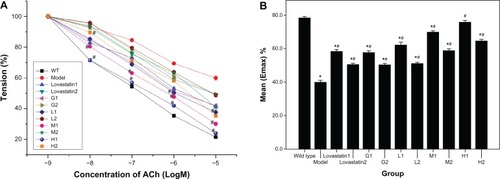Figures & data
Table 1 The plasma levels of lipids, lipoproteins, nitrite, and vWF in different groups of the study
Figure 1 Structure of genistein and DFMG (A) the structure of genistein and (B) the structure of 7-Difluoromethyl-5, 4′-dimethoxygenistein (DFMG).

Figure 2 Aortic lesion development (A) and quantification (B). (A) ORO-stained aortic arches from ApoE−/− mice that were fed a high-fat diet for 16 weeks in different groups and phases. Lesion staining is intensely focused at the aortic arch and at the branch points of the aorta. Compared with the atherosclerosis model group, the aortic lesion developed differently in the prevented and treated groups with different drugs. (B) Quantification of ORO staining in the aortic arch of ApoE−/− mice after consuming a high-fat diet in different groups and phases.
Abbreviations: DFMG-H(I), DFMG-prevented group (10 mg/kg/d, ig); DFMG-H(II), DFMG-treated group (10 mg/kg/d, ig); DFMG-L(I), DFMG-prevented group (2.5 mg/kg/d, ig); DFMG-L(II), DFMG-treated group (2.5 mg/kg/d, ig); DFMG-M(I), DFMG-prevented group (5 mg/kg/d, ig); DFMG-M(II), DFMG-treated group (5 mg/kg/d, ig); Genistein(I), genistein-prevented group (5 mg/kg/d, ig); Genistein(II), genistein-treated group (5 mg/kg/d, ig); Lovastatin(I), lovastatin-prevented group (5 mg/kg/d, ig); Lovastatin(II), lovastatin-treated group (5 mg/kg/d, ig); Model, atherosclerosis model group; ORO, Oil red O; WT, wild type group (C57BL/6J mice).

Figure 3 Acetylcholine (ACh)-induced endothelium-dependent relaxation (A) and the Emax (B) of thoracic aortic rings in different groups of mice previously contracted by phenylephrine (PE).
Abbreviations: GI, genistein-prevented group (5 mg/kg/d, ig); G2, genistein-treated group (5 mg/kg/d, ig); HI, DFMG-prevented group (10 mg/kg/d, ig); H2, DFMG-treated group (10 mg/kg/d, ig); LovastatinI, lovastatin-prevented group (5 mg/kg/d, ig); Lovastatin2, lovastatin-treated group (5 mg/kg/d, ig); LI, DFMG-prevented group (2.5 mg/kg/d, ig); L2, DFMG-treated group (2.5 mg/kg/d, ig); Model, atherosclerosis model group; MI, DFMG-prevented group (5 mg/kg/d, ig); M2, DFMG-treated group (5 mg/kg/d, ig); WT, wild type group (C57BL/6J mice).
